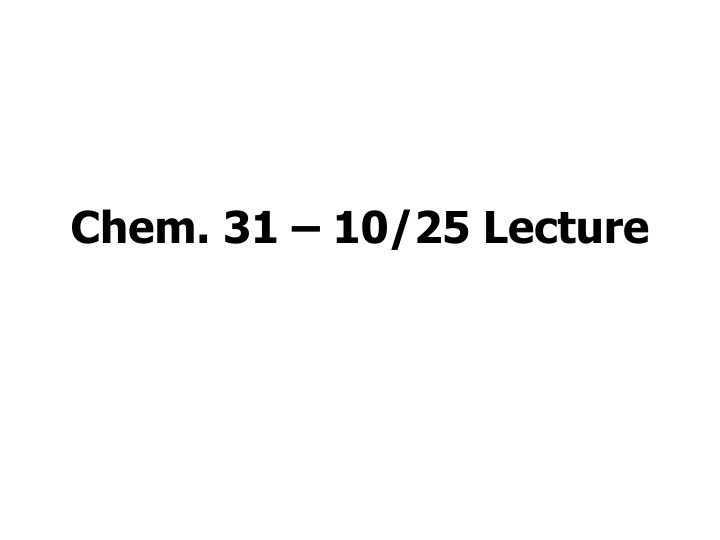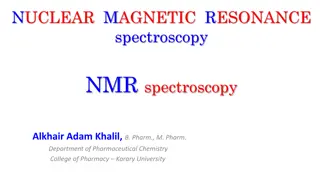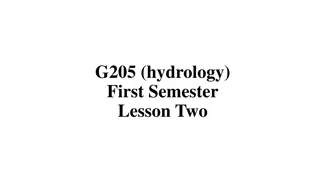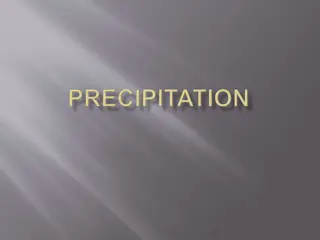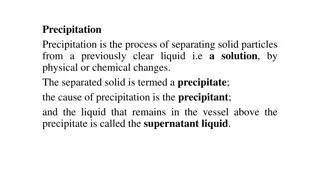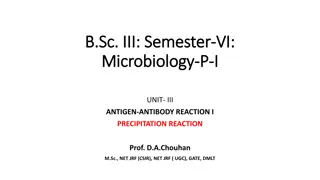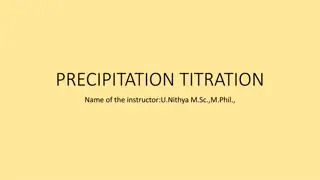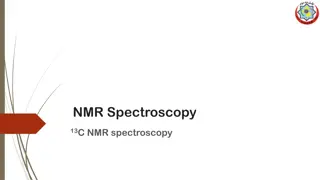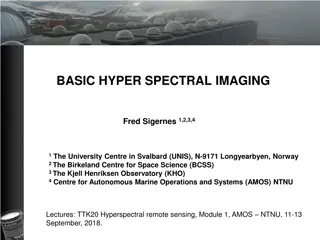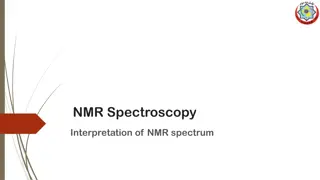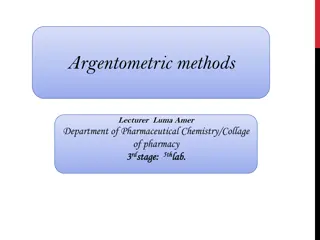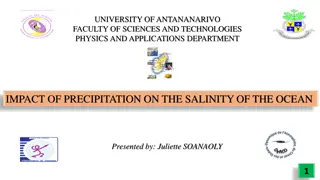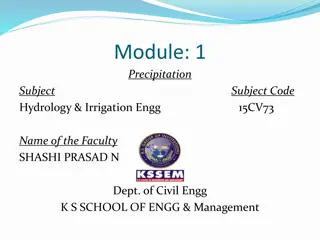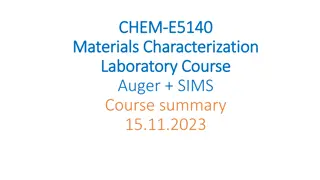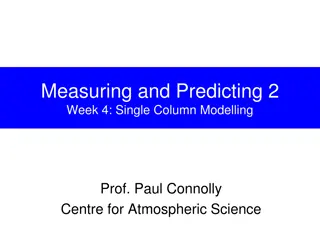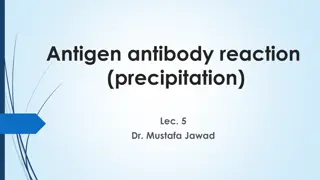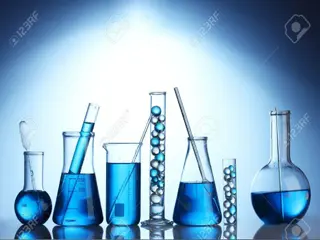Analyzing Precipitation Titrations and Spectroscopy in Chemistry Lecture
Exploring the concepts of precipitation titrations and spectroscopy in a chemistry lecture covering topics such as titration curves, sharpness at equivalence points, and titration of mixtures. The lecture delves into examples like the titration of Hg2^2+ by CrO4^2-, emphasizing the three regimes before, at, and after the equivalence point. Through qualitative analysis, students learn about the impact of Ksp values and ion concentrations on titration sharpness.
Download Presentation

Please find below an Image/Link to download the presentation.
The content on the website is provided AS IS for your information and personal use only. It may not be sold, licensed, or shared on other websites without obtaining consent from the author.If you encounter any issues during the download, it is possible that the publisher has removed the file from their server.
You are allowed to download the files provided on this website for personal or commercial use, subject to the condition that they are used lawfully. All files are the property of their respective owners.
The content on the website is provided AS IS for your information and personal use only. It may not be sold, licensed, or shared on other websites without obtaining consent from the author.
E N D
Presentation Transcript
Announcements Statistical Calculations Lab Resubmissions due today AA Lab Scheduled due date is 10/30 Today s Lecture Chapter 7 Titrations Precipitations (covered qualitatively this semester) Chapter 18 - Spectroscopy
Precipitation Titrations - covering qualitatively Example: Titration of Hg22+by CrO42- Hg22++ CrO42- Hg2CrO4(s) Ksp(Hg2CrO4) = 2.0 x 10-9 K = 1/Ksp= 5 x 108= large (reaction near full to product) Titration has 3 regimes: Before equivalence point (excess Hg22+in flask) [Hg22+] is high At equivalence point (nHg2^2+/nCrO4^2- = 1/1) [Hg22+] is rapidly decreasing After equivalence point (excess CrO42- in flask) [Hg22+] is low CrO42- Hg22+ This is different than text example
Titrations Shapes of Titration Curves Precipitation Example However, moles are not readily measured. Concentration or log[Hg22+] more readily measured. Log[Hg22+] or pHg22+ ( = -log[Hg22+]) is plotted on y- axis Plot of moles in flask vs. V(titrant) Easier to understand Hg Titration with Chromate 8.0 moles analyte At equivalence point both Hg22+ and CrO42- are 7.0 moles titrant 6.0 5.0 2+ present in low amounts [Hg22+] = Ksp1/2 pHg2 4.0 3.0 2.0 1.0 0.0 0 10 20 30 40 50 60 V(CrO42-) V(titrant) V(eq. pt.)
Titrations Shapes of Titration Curves Precipitation Example What affects sharpness at equivalence point? Ksp value (smaller means sharper) Concentration of ions (higher means sharper) Ksp(CO32-) < Ksp(CrO42-) <Ksp(SO42-) Hg Titration with Chromate Hg Titration 8.0 16.0 7.0 14.0 6.0 12.0 5.0 10.0 0.10 M Hg 0.010 M Hg 0.001 M Hg mercury(I) sulfate mercury (I) chromate mercury (I) carbonate pHg22+ pHg22+ 4.0 8.0 3.0 6.0 2.0 4.0 1.0 2.0 0.0 0.0 0 10 20 30 40 50 60 0 10 20 30 40 50 60 V(CrO42-) V(titrant)
Titrations Titration of a mixture Example: Titration of a mixture of CrO42- and CO32- by Hg22+ Since Ksp value for CO32- is smaller, it will precipitate first After CO32- precipitates to near completion, pHg drops to the point where CrO42- starts to precipitate Hg Titration of chromate and carbonate 18.0 16.0 14.0 12.0 10.0 pHg22+ 8.0 6.0 4.0 2.0 0.0 0 10 20 30 40 50 60 2+) (mL) V(Hg2 Which anion was initially present at higher concentration?
Chapter 18 - Spectroscopy A. Introduction 1. One of the main branches of analytical chemistry 2. The interaction of light and matter (for purposes of quantitative and qualitative analysis) 3. Topics covered: - Properties of Light - Absorption of Light - Electromagnetic Spectrum - Beer s Law - Spectrometers
Spectroscopy B. Fundamental Properties of Light 1. Wave-like properties: = wavelength = distance between wave crests = frequency = # wave crests/s = wave number = # wave crests/length measure c = speed of light (in vacuum) = 3.00 x 108 m/s Relationships: c = and = 1/ note: speed of light depends on medium (slower in water than in vacuum) not considered here
Spectroscopy Fundamental Properties of Light 1. Other wave-like properties - diffraction, interference 2. Particle-like properties a) Idea of photons (individual entities of light) b) Energy of photons E = h = hc/
Spectroscopy Absorption vs. Emission 1. Absorption - Associated with a transition of matter from lower energy to higher energy 2. Emission - Associated with a transition from high energy to low energy A + h A* h = photon A* A + h Excited State Energy Photon out Ground State Photon in
Spectroscopy Regions of the Electromagnetic Spectrum Many regions are defined as much by the types of transitions occurring (e.g. outer shell electron) as by the frequency or energy of the transitions Outer shell electrons Bond vibration Nuclear spin Short wavelengths Long wavelengths Gamma rays Microwaves X-rays UV + visible Radio waves Infrared High Energies Nuclear transitions Inner shell electrons Molecular rotations Low Energies Electron spin
Spectroscopy Some Example Questions 1. A nuclear magnetic resonance (NMR) spectrometer absorbs light at a frequency of 750 MHz. This is in the radio frequency and Hz = s-1. What is the wavelength of this light? An infrared absorption band occurs at a wavenumber of 812 cm-1. What is the wavelength (in m) and energy (J/photon) of that light? What type of light involves transitions of inner shell electrons? 2. 3.
Spectroscopy Beer s Law Transmittance = T = P/Po Absorbance = A = -logT sample in cuvette Light source Absorbance used because it is proportional to concentration Light intensity in = Po Light intensity out = P A = bC b Where = molar absorptivity and b = path length (usually in cm) and C = concentration (M) = constant for given compound at specific value
Spectroscopy Beer s Law Question Half of the 284 nm light is absorbed when benzoic acid at a concentration of 0.0080 M is in a cuvette with a path length of 0.50 cm. What is the molar absorptivity of benzoic acid at this wavelength?
Spectroscopy More on Beer s Law Useful for determination of analyte concentrations Some limitations Law not valid for high concentrations Deviations to law appear to occur when multiple wavelengths of light used or when multiple species exist but absorb light differently Uncertainties are lowest when 0.1 < A < 1 Example of deviations to Beer s Law: Unbuffered Indicator with (In-) = 300 M- 1 cm-1, (HIn) = 20 M-1 cm-1; pKa = 4.0 HIn H+ + In- 0.5 0.45 0.4 0.35 Absorbance 0.3 0.25 0.2 0.15 0.1 0.05 0 0 0.005 0.01 0.015 Total HIn Conc.
Spectroscopy Spectrometers light detector measures light intensity by converting it to an electrical signal sample in cuvette Data processor light source light discriminator: monochromator (passes only a small range of wavelengths) Components can look very different in different types of spectrometers, but spectrometers will have all of the major components (except other methods of wavelength discrimination may replace monochromators)
Spectroscopy Example Measurement: Ozone Ozone (O3) is a pollutant (lower atmosphere) and in stratosphere provides UV protection Instrument is used for measurement at station or in airplane compares absorbance through sample cell vs. absorbance through reference cell Can also make measurements remotely (e.g. absorbance between two skyscrapers) light source ( = 254 nm) chopper air in reference cell sample cell O3 scrubber light detector
